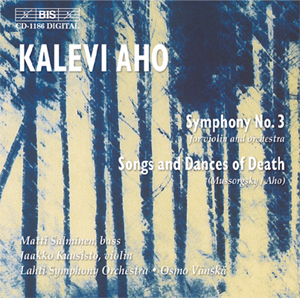The forthcoming 2003 Proms season will see the
British premiere of Kalevi Aho’s Ninth Symphony although
his extraordinarily wide ranging symphonic cycle has in fact now
reached twelve, the latest addition, Luosto Symphony, for
large orchestra, chamber orchestra, eleven "mountain musicians"
and two singers, being scheduled for its first performance on
the slopes of Luosto mountain in Lapland in August 2003.
Like the Ninth Symphony, which features
a concertante part for solo trombone, the Third Symphony
is a hybrid symphonic concerto. Aho did indeed start out with
the intention of writing a violin concerto before he realised
that the piece was taking him in a slightly different direction.
What we have therefore is very much a successful amalgam of the
two forms, a work of considerable technical virtuosity for the
soloist underpinned by an impressive sense of symphonic and organic
structure that is capable of being heard clearly upon first acquaintance.
In terms of language it is the ghost of Shostakovich that is most
clearly evident, an influence that the composer freely acknowledges.
Mahler is also evident on occasions and so, not surprisingly,
is Sibelius. Even at this relatively early stage of his career
however (he was only twenty two when he started work on the symphony)
Aho is able to weld these influences into something that is his
own, at the very least a work that demonstrates a powerful musical
imagination at work.
Cast in four movements, the first is predominantly
preoccupied with the soloist who enters after a quiet opening
passage on percussion. A freely elegiac melody slowly gains in
intensity until woodwind join well over three minutes into the
movement. The central section that follows makes considerable
use of high woodwind. There are also pre-echoes of the third movement
funeral march to come before the sorrowful mood returns. The violin
fades mysteriously into the distance with an accompaniment of
percussion taking us back to the opening material. At no point
in the opening movement do we hear the full orchestra. It is therefore
with considerable effect that Aho unleashes his forces in the
Prestissimo second movement with a vigorous brass dominated
call to arms that plays an important part in the ensuing material.
The orchestra dominate throughout this movement to the point that
the soloist is lost in the cacophony. The violin’s urgent interjections
are gradually overpowered until the opening call to arms returns.
The music grows in brutality until the final bars, which are hammered
out in rhythmic unison. The silencing of the soloist holds for
the entire Lento third movement, which opens and closes
with a sustained unison melody in the violins. The strings are
subsequently joined by the woodwind in a passage where Sibelius
is not too far away. The centre of the movement is essentially
a funeral march, perhaps the closest the symphony comes to Mahler.
The march builds inexorably to a dramatic climax amongst peeling
bells before the music subsides once more into the unison violin
melody with which it opened. Having been pushed aside by the orchestra
during the two central movements the final movement, marked Presto,
once again belongs to the soloist. He has an agile cadenza followed
by an extraordinary passage in which the violin is pitted against
martial percussion. Eventually the soloist is drowned out once
again before the work progresses towards its quiet, consolatory
conclusion.
Young Finnish violinist Jaakko Kuusisto is a
more than able soloist in a part that is as demanding as you would
expect of any full blown concerto. The ever growing reputation
of the Lahti Symphony Orchestra under the authoritative direction
of Osmo Vänskä is justified by boldly confident playing
invoking a vivid atmosphere.
Aho’s orchestration of Mussorgsky’s Songs
and Dances of Death came about as the result of a request
for an arrangement suitable for performance by bass and orchestra.
Aho explains that his orchestration was conceived around a "psychological
instrumentation" whereby the specific instrumentation was
decided upon following careful analysis of the poems. The appointment
of instruments is suitably matched to the expressive content of
the words. The orchestration certainly adds drama to the profoundly
pessimistic nature of the poems, not least in the concluding song,
The Field Marshal. The battle scene of the opening possesses
particular presence. Matti Salminen proves a sonorous bass if
not always the most subtly expressive and the orchestra are once
again on fine form.
Overall, this is a disc not to be missed, both
for the undoubted stature of the symphony and the quality of the
recording. The BIS engineers have captured the orchestra and soloists
with an admirably natural sense of space, orchestral perspective
and sonic range. All in all it makes for an edge of the seat experience
and I would be surprised if I hear a better produced orchestral
recording this year. I have already have it earmarked as one of
my discs of 2003.
Christopher Thomas
